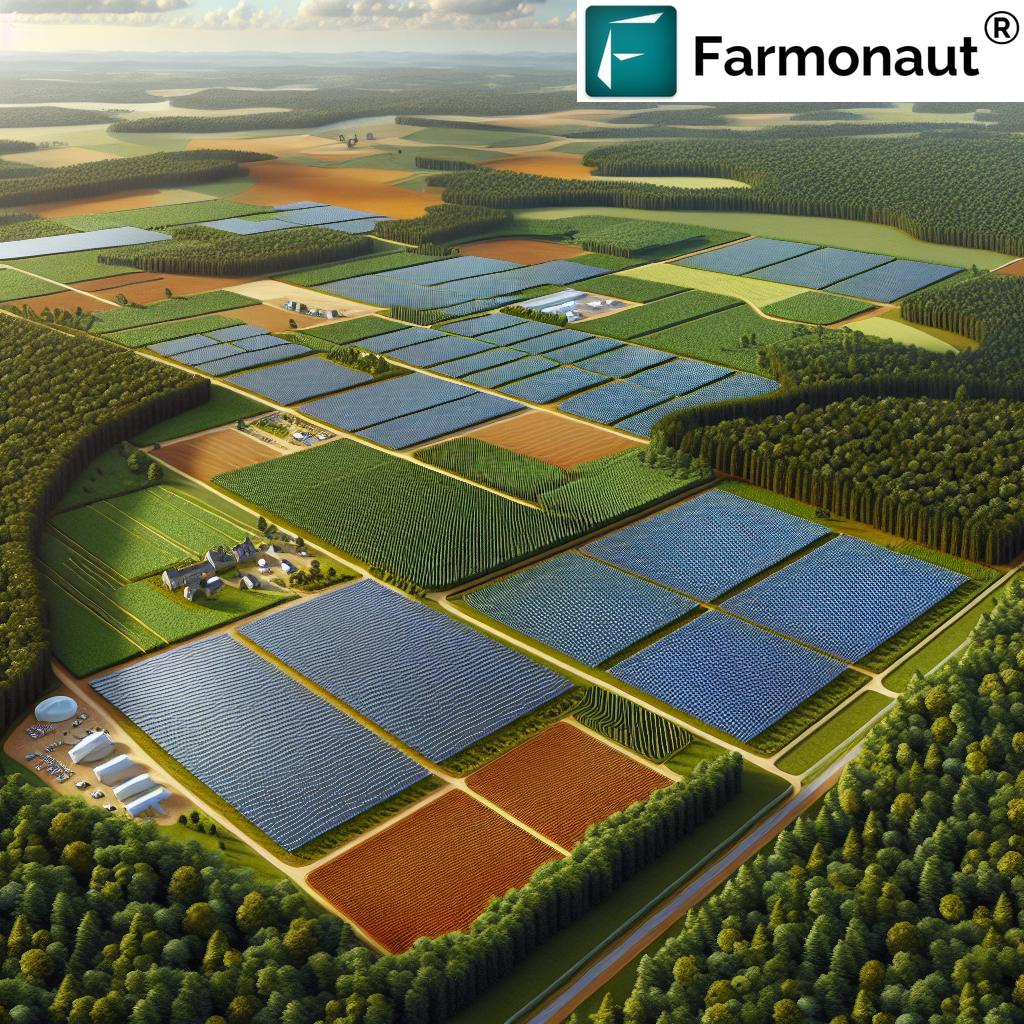What Zoning Is Needed for a Solar Farm in Powhatan? – A Comprehensive Guide to Solar Farm Zoning Regulations, Agricultural Land Use, and Environmental Impact
“Over 70% of Powhatan’s solar farms are zoned on agricultural land, balancing energy needs with farmland preservation.”
Introduction
As the global shift towards renewable energy accelerates, solar farm development stands out as a pivotal strategy for expanding clean energy production. However, integrating solar farms into existing rural, agricultural, and forestry landscapes brings forth critical questions: What zoning is actually needed for a solar farm in Powhatan County, Virginia? How do solar farm zoning regulations impact agricultural land use, conservation, and the local economy? And what are the best practices for minimizing the environmental impact of solar farms?
In this exhaustive guide, we examine:
- The zoning requirements and regulatory processes shaping solar farm development in Powhatan and similar regions
- The unique challenges of mixing solar production with agricultural and forestry activities
- How local laws and buffer zones are enforced to preserve the community’s interests and natural habitats
- Best practices and technology tools that help landowners, developers, and policymakers balance energy goals with land preservation
- Where Farmonaut’s precision agriculture solutions can support these objectives
How Farmonaut’s Satellite Technology is Revolutionizing Land Use in Agriculture
Understanding Solar Farm Zoning Regulations in Powhatan
Zoning regulations serve as the backbone of local land management strategies, defining permissible uses for every parcel of property. In Powhatan and similar counties, these laws are particularly pivotal for solar farm development, as they dictate where and how solar projects can be developed.
- Zoning overlays and districts: Counties like Powhatan use zoning overlays to categorize land parcels into agricultural, industrial, residential, and commercial zones.
- Primary zoning classifications: Each zone comes with a predefined list of permitted and conditional uses. For solar, this typically relates to size restrictions, energy production limits, and environmental impact assessments.
- Community objectives: Zoning helps align solar farm development with the community’s long-term stewardship goals, ensuring responsible deployment that protects farmland and natural habitats.
For Powhatan specifically, an important recent change is the amendment by the County Board of Supervisors to direct solar installations away from agricultural zones and towards industrial zones ([Source](https://richmondbizsense.com/2024/08/05/powhatan-changes-zoning-rules-to-discourage-solar-farms-on-agricultural-land/?utm_source=openai)). This demonstrates how evolving zoning regulations can impact energy projects on the ground.
Zoning Requirements for Solar Farms on Agricultural Land in Powhatan
The agricultural land use for solar farms has fueled much debate in Powhatan. Agricultural zones are typically designated to preserve food production, rural economies, and open space. Yet, the demand for renewable energy has introduced interest in repurposing portions of this land for solar farms.
Solar Farm Zoning Status and Permitting
Historically, Powhatan permitted solar as a conditional use on agriculturally zoned land. In response to rising local community concerns about solar farms and the risk of farmland conversion, new amendments have been enacted:
- Solar farms are now largely restricted in agricultural zones; instead, they are permitted or conditionally allowed on industrial properties (see [official zoning update](https://richmondbizsense.com/2024/08/05/powhatan-changes-zoning-rules-to-discourage-solar-farms-on-agricultural-land/?utm_source=openai)).
- For any exceptions, special permits may be required, which involve an extensive review process including environmental impact assessments and neighbor notifications.
Size Limitations for Solar Projects
To preserve active agriculture, size restrictions are established. While these vary across counties, the intention is to:
- Limit the total area (acres) that can be converted to solar, e.g., between 2.5 and 30 acres for accessory or medium-sized installations (examples).
- Maintain critical thresholds to protect prime farmland and ensure food security.
Agricultural Impact Mitigation
Developers seeking to establish solar farms on farmland must submit detailed plans showing:
- Minimal disruption to ongoing farming operations.
- Restorability of the land after the end of the solar project’s life.
- Compliance with any state “Prime Farmland Rules” (e.g., Minnesota restricts solar-built acreage to 0.5 acres per MW).
- Possible requirements for agrivoltaic systems to enable dual land use—energy and agriculture.
Key Solar Farm Setback Requirements
To address visual impacts, neighbor privacy, and ecological preservation, setbacks around installations are dictated by local law:
- In Powhatan, setbacks are often at least 100 feet from property lines.
- Height restrictions for panels (typically below 20 feet).
- Additional setbacks if the solar farm is located near wetlands, wildlife habitats, or residential zones.
Satellite & AI Based Automated Tree Detection For Precise Counting and Location Mapping
Farmonaut’s satellite-powered carbon footprint tracking tools
can help landowners measure and mitigate the environmental impact of solar farms and other energy projects.
For businesses, Farmonaut Fleet Management enables optimized deployment of vehicles,
reducing operational costs and overall carbon emissions—an essential part of environmentally conscious farm and solar operations.
Industrial, Commercial, and Residential Zoning Rules for Solar Installations
Zoning regulations in Powhatan extend beyond agricultural lands to impact solar project siting in other zones:
- Industrial Zones: Now the preferred location for large-scale solar farms in Powhatan. These lands are typically intended for heavy industry, manufacturing, and utility-scale energy production. Solar installations are most often permitted as a principal or conditional use.
- Commercial Zones: Allow for solar as accessory uses (e.g., rooftop solar on businesses) rather than ground-mounted, utility-scale farms. Often size and visual impact limitations apply.
- Residential Zones: These are set aside for housing and related community services. Typically, solar is only allowed for small-scale, personal use systems and is neither permitted nor suitable for major solar farm developments.
As a result, most utility-scale solar farms in Powhatan must now target industrially zoned properties, where setback and buffer rules still apply but agricultural impacts are minimized. This local regulatory shift is a prime example of how community concerns about solar farms influence local law.
Farmonaut Introduction – Large Scale Usage For Businesses and Governments
Solar Farms in Forestry Areas: Zoning and Environmental Considerations
The opportunity to install solar farms in forestry areas presents both promise and challenge. Forestry lands are designated for habitat conservation, timber production, and preserving ecological balance. Zoning regulations here are most stringent, reflecting the critical need to safeguard biodiversity and natural resources.
Key Regulatory Requirements
-
Land Use Restrictions: Forestry zones in Powhatan and comparable communities require exhaustive justification for any conversion to solar. Only projects with minimal environmental impact and clear conservation offsets may be considered.
(See: Boulder County, Colorado, where special reviews limit agricultural and forestry land conversions source.) - Environmental Impact Assessments Required: Prior to approval, developers must perform comprehensive ecological studies covering potential disruption to wildlife, wetlands, forest health, and water resources.
- Buffer Zones and Setbacks: To protect local ecosystems, law mandates buffer setbacks (in Alberta, 15 to 30 meters around wetlands and natural habitats; in Powhatan, at least 100 feet from property edges) to preserve ecological integrity.
- Reforestation and Habitat Restoration Plans: For each acre affected, restoration or reforestation plans are often mandated—ensuring a net conservation outcome, even if some trees or habitats are impacted.
For solar developers, careful consideration of conservation goals, use compatibility, and ongoing management strategies is crucial. Tools like Farmonaut’s crop, plantation & forest advisory support sustainable monitoring and compliance.
“Solar projects in Powhatan require setbacks of at least 100 feet from property lines to protect local ecosystems.”
Analyzing the Environmental Impact of Solar Farms
One key element in solar farm zoning regulations is measuring and managing environmental impacts. This not only relates to zoning permit requirements, but also helps maintain community trust and regulatory certainty.
Typical Environmental Assessments Include:
- Wildlife Impact Studies: Analysis of how solar projects may affect local habitats, migratory patterns, and threatened species within or around the project area.
- Water Resources & Wetland Buffers: Evaluation of runoff, water table changes, and proximity to wetlands; strict buffer zones are mandated to protect these sensitive areas.
- Soil Erosion and Vegetation Loss: Avoiding erosion and soil quality loss during both construction and operation; maintaining native vegetation under or around solar arrays.
- Glare and Visual Impact: Placement and angling of panels to reduce light pollution, especially near residential or conservation lands.
- Decommissioning and Restoration: Developers must submit end-of-life restoration plans, ensuring that land can be reused for its original purpose after the project ends.
Local Example: In Illinois and other states, farms must maintain setbacks (e.g., 50 feet from property lines, 500 feet from homes, max panel heights of 20 feet), and submit comprehensive environmental review documents as part of the permitting process ([see Illinois example](https://www.illinoisrenew.org/specialized-applications/smart-zoning-solutions-that-make-solar-farms-work-in-illinois/?utm_source=openai)).
Farmonaut® | Making Farming Better With Satellite Data
For food brands and textile businesses aiming for transparent supply chains, Farmonaut’s
blockchain-based traceability solution
ensures every stage—from farm to consumer—can be verified. This is especially valuable for large-scale solar and agriculture projects seeking to demonstrate sustainability compliance.
Best Practices for Integrating Solar into Agricultural and Forestry Landscapes
Integrating solar farms into our landscapes requires solutions that respect both sustainable energy production and land stewardship. Here are the most effective strategies, recognized as best practices worldwide:
1. Agrivoltaics: The Dual-Use Approach
Agrivoltaics best practices involve combining solar arrays with agricultural activities—such as grazing, specialty crops, or pollinator habitats. This means:
- Farms continue producing food or supporting livestock, while also generating solar energy.
- Studies indicate land use efficiency can increase by 60–70%, as land yields both energy and produce (source).
- Improved microclimates and potential reduction in land surface temperatures.
- Supports long-term land preservation and solar projects in a way that aligns with community goals.
2. Community Engagement and Transparency
Siting solar projects in rural or ecological areas demands early and ongoing engagement of local property owners, farmers, and conservationists:
- Explaining both the benefits (jobs, tax revenue, emissions reduction) and the potential concerns (visual, habitat, or land use impacts).
- Establishment of community review boards or advisory committees to oversee planning.
- Use of digital platforms like Farmonaut’s large-scale farm management suite for transparent crop, soil, and resource monitoring.
3. Adaptive Management Strategies
Solar farm operators should plan for ongoing monitoring and adaptive adjustments:
- Regular review of environmental impacts using satellite and on-site data
- Flexible operations plans to address newly identified ecological risks
- Participation in local feedback mechanisms for addressing legitimate community complaints
4. Policy Development and Harmonization
Coordinated solar energy development guidelines at the local, county, and state levels help streamline processes and avoid conflict. Key elements include:
- Standardization of zoning requirements for solar installations and setback rules
- Promotion of low-impact technologies and dual-use strategies
- Post-project land restoration policies to ensure that land can return to agricultural or habitat status when the solar farm is decommissioned
Zoning Requirements and Environmental Considerations for Solar Farms in Powhatan
| Zone Type | Zoning Status (Permitted/Conditional) |
Minimum Land Size Required (Acres) |
Agricultural Land Use Impact (Low/Medium/High) |
Environmental Review Needed | Typical Approval Timeframe (Months, Estimated) |
|---|---|---|---|---|---|
| Agricultural | Conditional / Special Permit (Increasingly Restricted) | 2.5–30 (Depends on Use Category, Local Rules) | High (Conversion impacts food production & rural economies) | Yes (Comprehensive Impact Assessments Required) | 3–9 |
| Industrial | Permitted or Conditional (Preferred for Utility-Scale Solar) | Varies (Typically No Minimum) | Low (No direct ag land displacement) | Yes (Standard Review Required) | 3–6 |
| Commercial | Accessory Use (Limited Scale, Rooftop Focus) | Small (<2.5) | Low | Yes (Simplified Review for Small-Scale) | 1–3 |
| Residential | Accessory Use Only (Personal Homes) | Very Small (Individual Lot) | Low | No (If Under Thresholds) | 1–2 |
| Forestry | Conditional (Very Limited, Stringent Review) | Varies (Strict Case-by-Case Evaluation) | Medium–High (Ecological Restoration Often Required) | Yes (Extensive, incl. Buffer Zone Mapping) | 6–12+ |
This comparative summary highlights the zoning requirements and environmental review processes for solar farm development across Powhatan’s core land categories. For further guidance or custom land suitability assessments, precision satellite-based monitoring adds objective insight—ask us at Farmonaut!
Farmonaut Solutions: Enhancing Land Use, Conservation, and Solar Project Success
As a pioneering provider of advanced, satellite-based agricultural management tools, we at Farmonaut enable property owners, agribusinesses, and communities to navigate the complexities of solar zoning regulations and land conservation. Our key offerings include:
Real-Time Land and Crop Health Monitoring
Using multispectral satellite imagery, Farmonaut’s platform provides actionable insights for crop health, soil moisture, and field conditions. This strategic data empowers farmland owners and solar developers to optimize land use compatibility—whether pursuing dual-use (agrivoltaics), maintaining productivity during construction, or attaining compliance with zoning requirements.
Precision Resource Management & Advisory
The Farmonaut Jeevn AI Advisory System delivers:
- Instant weather, crop, and threat alerts—crucial for adaptive management on solar-enabled agricultural lands.
- Data-driven recommendations to reduce inputs (like water and fertilizer), in support of land preservation and sustainable operations.
Blockchain-Based Traceability
To address stakeholder and regulator demands for transparency, our traceability systems offer secure, immutable records for solar projects and agricultural outputs. This robust chain-of-custody solution enhances both community trust and supply chain accountability.
For more information, explore Farmonaut’s dedicated Product Traceability page.
Carbon Footprint Tracking for Solar & Agriculture
Farmonaut’s carbon management solution lets users:
- Monitor emissions and environmental footprint for any land parcel or energy installation.
- Support regulatory compliance for zoning permits and ongoing project reporting.
Visit our Carbon Footprinting hub for details.
Scalable, Affordable Access
Our subscription packages are designed for all stakeholders—from individual farmers to large-scale solar developers and policymakers. For large, complex, or multi-site operations, the
admin dashboard extends monitoring, reporting, and adaptive management at scale.
All of our data solutions are easily accessible on Android, iOS, and the web, making precision land management easier and more affordable than ever.
Frequently Asked Questions – Solar Farm Zoning in Powhatan
Q1: What types of land are best suited for solar farms in Powhatan?
Industrial-zoned properties are now the preferred sites for utility-scale solar farm development. Agricultural land faces stricter restrictions unless solar projects demonstrate minimal agricultural impact and secure special permits. Forest and conservation lands generally face the highest barriers due to environmental protection requirements.
Q2: What environmental assessments are required for solar installations?
Local ordinances typically require wildlife studies, water and wetland analysis, soil stability evaluation, and a glare/visual impact assessment. Decommissioning and land restoration plans are also often mandated.
Q3: Are community concerns about solar farms considered during permitting?
Absolutely. Public hearings, neighbor notifications, and written feedback are standard components of the zoning process. Community planners work to balance benefits with visual, ecological, and economic impacts.
Q4: Can solar and agriculture or forestry co-exist on the same property?
Yes. Through agrivoltaics best practices, farmers can raise crops or livestock under and around solar panels, maximizing land use and providing mutual economic and ecological benefits.
Q5: How can satellite and AI tools support solar farm planning and compliance?
Farmonaut’s satellite imagery and advisory tools enable ongoing monitoring for environmental impact, vegetation health, and carbon emissions—streamlining reporting, supporting dual-use solutions, and improving overall sustainability outcomes.
Conclusion
The intersection of solar energy development and land preservation is complex but navigable—with the right knowledge, community engagement, and technology support. In Powhatan and similar counties, zoning laws and regulations dictate not only where solar farms can be built, but how they must balance energy production with long-term ecological and agricultural objectives.
By adopting solar farm zoning regulations rooted in clear scientific assessments, community feedback, and adaptive management, we can ensure that renewable energy growth complements rural landscapes, protects local food systems, and advances sustainability goals for all.
Explore Farmonaut’s Carbon Footprint Tracking Tools →
Get Started with Farmonaut Web App →


















